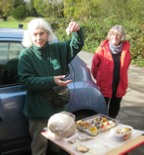

Web design © Graeme de Lande Long. Terms & Conditions.



Community Website
Scaynes Hill Village
Rosalie started us off in the small area of woodland just to the north of the Common, where we were constantly surprised by how many fungi we found if we just looked carefully. There must have been nearly twenty different species; some of them, such as earthballs, being very abundant. Rosalie was fantastically knowledgeable about the various species we found and was a mine of information about fungi generally. Not daunted, and despite having spent the best part of an hour in the small patch of woodland, Rosalie then led us into the main part of Costells Wood where we found and identified even more species. The party eventually returned to our starting point where Rosalie was presented with a gift of a plant and some chocolates to thank her for giving us such an interesting morning.
A nonagenarian artist and fungus expert, Rosalie Sinclair-Smith, gave a group of nearly two dozen villagers a fascinating insight earlier this month into the life and importance of the fungi that surround us. Although a great advocate of the gourmet qualities of the edible fungi, Rosalie started her Fungus Foray in Costells Wood with words of caution by telling us that 8 people had died in France last year from eating poisonous fungi. The Death Cap being a particular culprit since eating only one can release enough poison to destroy the functioning of the kidneys and liver - and there's no cure!
Rosalie gave us a brief introduction to fungi and their important symbiotic relationship with plants and insects. Fungi play an essential role in decomposition of organic matter and have a fundamental role in nutrient recycling and exchange. Fungi are not plants as they contain no chlorophyll and cannot photosynthesize to produce energy and grow. The fungi we see are only the fruiting part of a vast network of mycellium (thread like roots) that exist beneath the ground. The mycellium interact with the roots of plants, particularly some trees, from which they extract carbohydrates such as glucose and sucrose. In return, the plant gains the benefits of the mycelium's higher absorptive capacity for water and mineral nutrients due to the comparatively large surface area of mycelium thus improving the plant's mineral absorption capabilities.


Fungus Foray in Costells Wood
31-Oct-14 posted by Graeme de Lande Long




Rosalie & specimen fungi
Abundant Common Earthballs
Ivory Funnel Caps